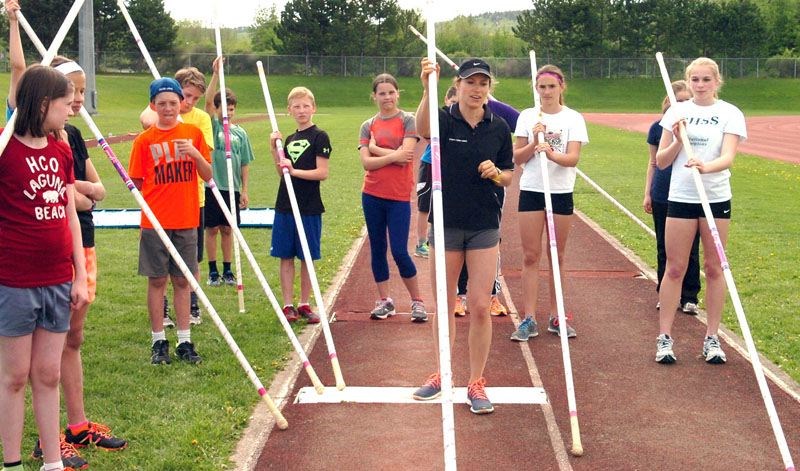Pole vaulting has to be considered the extreme sport of track and field.
No other event inspires fear quite like running as fast as you can before placing a flexible pole in a hole to anchor one end and then springing your body high into the air to clear a bar.
Bad things happen. Poles break, vaulters lose their grip on the way up and miss the mats on landings. It's the only track and field event in which helmets are worn.
The men's world record belongs to French athlete Renaud Lavillenie, who in February set the indoor standard when he cleared 6.16 metres (20 feet, 2 1/2 inches). Yelena Isinbayeva of Russia owns the women's record of 5.06m (16 feet, seven inches).
None of the 33 youngsters who signed up for a Prince George Track and Field Club camp were thinking about world domination during a special jumps/hurdles/sprint practice put on Saturday by guest coaches Robyn Webster and Tessa Gray-Burnett.
"Kids have fear before they start but once they start there's such a progression, it takes a long time to build up to actually jumping off the ground and holding high enough to be in the air long enough to have any fear," said Webster. "As soon as they start they realize it's not that bad."
Webster, 26, grew up in Merritt as a sprint/jumps specialist and didn't start pole vaulting until she became a university athlete in Calgary. She now heads the Dino Youth Track and Field Club and is an assistant coach with the Calgary Warriors Track Club. She still competes in CIS meets and is trying to make the national team.
"It takes total body strength and spacial awareness and more than anything, mental strength to be able to progress," Webster said. "If you want to keep improving you have to get a bit riskier each time. I find long jumpers and hurdlers make the best pole vaulters."
Webster attended the Gary Reed camp in Prince George a year ago , which sparked local interest in the pole vault. For 16-year-old Kuort Bishop, Saturday's practice was a chance to build on the technique he started perfecting two years ago when he was living in Phoenix, Ariz., being trained by Nick Hysong, the 2000 Olympics pole vault champion.
Bishop is more than halfway to the world record, having cleared 3.3 metres. He won the North Central zone high school meet last week and is qualified for the pole vault this weekend at the provincial high school championships in Langley.
"Everyone's amazed by it, it's different," said Bishop.
"You have to learn where your feet are supposed to go, what foot to go off of, and where your feet should be in the air. What I see a lot of people doing is their grip on the pole is slipping and they're too scared to vault. You just need to be strong about it. I'm working on the speed, so I can go to higher heights."
Back in the day, when PGTFC head coach Bill Masich was climbing the ranks as a track athlete, the pole vault and the hammer throw were the only events not available locally to high school kids, simply because the equipment wasn't available. Now the club has a selection of poles, a set of vault standards and a padded box and safety mats, and they're not gathering dust.
"I find a lot of kids want to do pole vault but it's harder than they think it is," said Masich. "It looks so easy when you watch it at the Olympics, the people are so graceful and effortless when they do it. It's getting to that point that's the problem. When the reality kicks in that there's lot of technical work to do, then they get nervous. But the kids who start it and like want to do it all the time."
Gray-Burnett, a 30-year-old Calgary native and 400m hurdles specialist, retired last year after her seventh national championship. She told the kids the trick to hurdles is to not jump too high so that it slows your horizontal progression. That requires flexibility and proper form. Height is an obvious advantage.
Kids love to run and jump over barriers, so running hurdles is natural progression once they get to the track. There's a bit of a danger element to that event as well, but once they learn the technique there's usually no holding them back.
"If you're a hurdler, you're not a real hurdler until you've hit a hurdle," said Gray-Burnett. "With the little ones I always like to start lower because a lot of people are kind of scared to go over them and the more hesitant you are, the more likely you're going to hit one.
"You kind of have to treat it as a running event and get them to run through the hurdles, so having some smaller hurdles that collapse easy is the best way to start it. If they do hit one it's not as big of a blow to the body."



